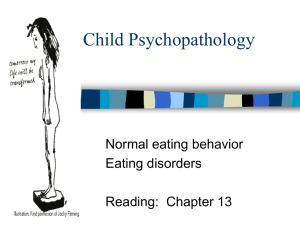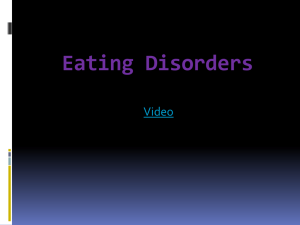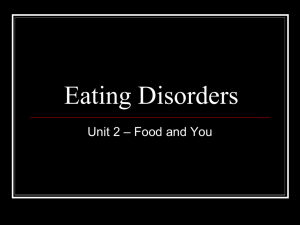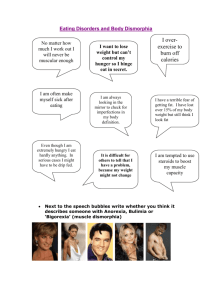Eating Disorders
advertisement
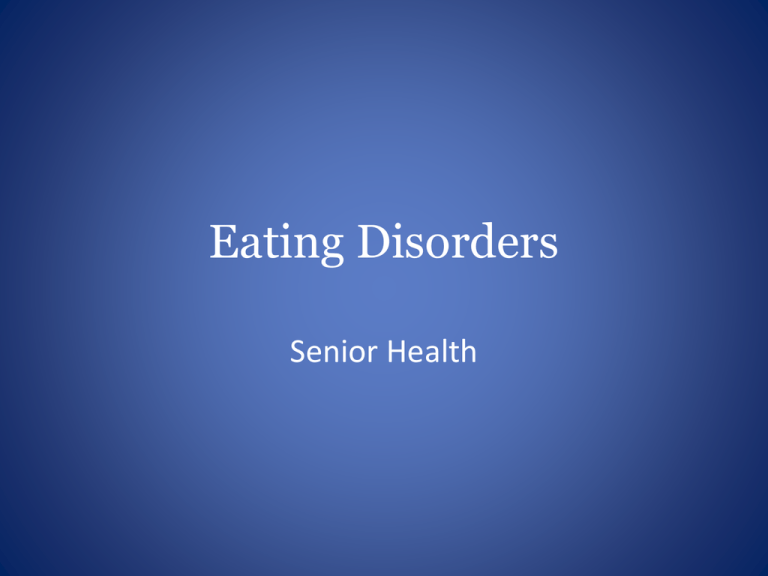
Eating Disorders Senior Health Objectives • Differentiate between common eating disorders • Identify warning signs, risk factors, and symptoms • Discuss how to help an individual with an eating disorder Introduction • Eating disorders are conditions that cause a person to have unhealthy thoughts and behaviors related to food and body image • People go to the extreme with their food habits to personally address their condition • Causes of eating disorders are thought to be due to a number of physical, psychological, cultural, and social factors Introduction Continued. . . • Eating disorders most common in teenage girls and young women, however they can occur in any sex or at any age • Those with the disorders may develop serious health problems (malnutrition, dehydration) • Other health risks – Menstrual period changes – Osteoporosis – Heart and organ complications Primary Treatment is counseling True or False? Quick Facts • HERE WE GO. . . – Over 8 million people in the United States – 95% of those people between ages 13-25 – ½ of girls between the ages of 11 and 13 see themselves as overweight – 42% of 1st through 3rd grade girls want to be thinner – 80% of 10 year olds are afraid of becoming fat – What percentage of people with eating disorders are men??? • 10% What is Anorexia (Nervosa)? • What do people with Anorexia do? – People with Anorexia have an INTENSE fear of gaining weight. They severely limit the amount of food they eat, thus becoming dangerously thin. – Affects the body AND mind. A simply diet becomes an obsession and gets out of control (food, dieting, weight loss) – Distorted body image… Anorexia Nervosa • Starts in teen years and usually affects females • Early treatment can be very effective, however if left untreated it can become a lifelong issue… early treatment is key. • If untreated, it can lead to starvation and other serious health issues: – – – – Osteoporosis… Kidney damage/failure Heart problems Change in menstrual cycle Symptoms of Anorexia • People with the disorder are often in DENIAL or do not realize that have a problem • Loved ones usually are the ones to get help • Characteristics of those with Anorexia: – – – – – – – – Weigh much less than healthy or normal Are VERY afraid of gaining weight Refuse to stay at a health weight THINK they are overweight when they are thin (body image) Obsess about food, weight, dieting Limit their food intake Over-exercise… Go to the extreme to lose weight Anorexia Diagnosis • A person’s weight will be compared to a normal weight for someone of the same height and age • Examinations on heart, lungs. BP, skin, hair… • Blood work… • “How do you feel?”… Photos What is Bulimia (Nervosa)? • What do people with bulimia do? – Binge and purge – Binging- eating a large amount of food in a short period of time – Purging- doing something to get rid of the food • Self Induced Vomiting • Over exercise • Medicines/laxatives What is Bulimia? • Binge and Purge Cycle – People binge because it gives them a feeling of comfort – Eating too much then makes them feel out of control – After they binge, they feel ashamed, guilty, and afraid of gaining weight – Purging occurs Health Risks • Acid from vomiting results in tooth decay, gum disease, and loss of tooth enamel • Osteoporosis • Kidney damage/failure • Heart problems Symptoms of Bulimia • Binging on a regular basis • Large amounts of food are consumed over a couple of hours or less. While this is happening, people feel they are unable to stop eating and feel hopeless • In an effort to avoid weight gain, people purge by: – vomiting – Exercising very hard for a long time – misusing laxatives, enemas, water pills (diuretics), and other medicines Bulimia • How can I know if someone has bulimia? – Bulimia is different from Anorexia…how? – Someone with Bulimia may be at a normal… – People with Bulimia are very, very, very….??? • SECRETIVE – What they do: • Go to the bathroom right after meals • Overeat but do not gain weight • Are secretive about eating, hides food, do not eat around others • Has teeth marks or calluses on the back of her hands or swollen cheeks or jaws…this is caused by self induced vomiting Photos Treatment of Eating Disorders • Early treatment is crucial because the longer it is there, the harder it is to rid • Those with only a few signs/symptoms should get help NOW • Treatment can teach someone healthy eating habits and boost self confidence • Physical only, right? – You may see a doctor, dietician, and counselor…hospital? – Treatment takes time and people can fall back into the disorder Causes of Eating Disorders • Causes are UNCLEAR and experts are in the dark about them • Factors may include family history, social factors, and personality traits • You may be more likely to have anorexia if: – A family member has had an eating disorder – Job/sport stresses body size… – You’re a perfectionist, never feel good enough, worries a lot – You’re dealing with stressful events… What should you do? • Tell someone who can make a difference – Parent – Teacher – Counselor – Doctor – Martin Mullarney SOONER THE BETTER!!! Other Eating Disorders • Binge Eating Disorder: Frequent episodes of eating what others consider abnormally large amounts of food…you are unable to control your eating, despite being full. – Elevated risk factors… – Disordered Eating: your eating habits have no sequence…restricting dieting, infrequent binging, infrequent purging, laxative abuse, diet pill abuse

